engine coolant AUDI A5 COUPE 2011 User Guide
[x] Cancel search | Manufacturer: AUDI, Model Year: 2011, Model line: A5 COUPE, Model: AUDI A5 COUPE 2011Pages: 362, PDF Size: 84.88 MB
Page 277 of 362

Checking and filling Ill
-------------~--
Closing the engine hood
- Pull the hood down until the pressure from the struts is
reduced.
- Let the hood
drop down and latch in place. Do not try to
push it shut;
it may fail to engage=:> &.
& WARNING
A hood that is not completely latched could fly up and block your
view while driving.
• When you close the engine hood, check it to make sure the
safety catch has properly engaged. The hood should be flush with
the surrounding vehicle body parts.
• If you notice while driving that the hood is not secured prop
erly, stop at once and close it. •
Working in the engine compartment
Be especially careful whenever you work in the engine
compartment.
Whenever you must perform any work in the engine compartment,
for example checking and filling different fluids, there is a risk of injury, burns and accidents. To prevent personal injury always
observe the following WARNINGS. The engine compartment of any
vehicle is a hazardous area=>& .
& WARNING
To help avoid injury, before you check anything under the hood:
• Turn off the engine.
• Remove the ignition key.
• Apply the parking brake.
Safety first
& WARNING (continued)
• Move selector lever of automatic transmission to "P" (Park);
put manual transmission in Neutral.
• Always let the engine cool down. Hot components will burn
skin on contact.
• To reduce the risk of being burned, never open the hood if you
see or hear steam or coolant escaping from the engine compart
ment. Wait until no steam or coolant can be seen or heard before
carefully opening the hood.
• Keep children away from the engine compartment.
• Never spill fluids on hot engine components. They can cause a
fire.
• Never touch the radiator fan. The auxiliary electric fan is
temperature controlled and can switch on suddenly.
• Never open the coolant reservoir cap when the engine is still
warm. The coolant system is pressurized and hot coolant could
spray out.
• Protect your face, hands and arm from steam or hot engine
coolant by placing a thick rag over the cap when you open the
coolant reservoir.
• If work on the fuel system or the electrical system is necessary:
-Always disconnect the battery.
- Never smoke or work near heaters or open flames. Fluids in
the engine compartment could start a fire.
- Keep an approved fire extinguisher immediately available.
• To avoid electrical shock and personal injury while the engine is
running or being started, never touch:
-Ignition cables
- Other components of the high voltage electronic ignition
system.
• If you must perform a check or repair with the engine running: ..,
Vehicle care Technical data
Page 278 of 362

lffll __ C_h_ e_c _k _i_n -=g :a,__ a_n_ d_ f_ i_ l _li _n _,g;._ __________________________________________ _
& WARNING (continued )
-First, fully apply the parking brake , move selector lever of
automatic transmission to "P" (Park); put manual transmi s
sion in Neutral.
- Alway s use extreme caution to prevent clothing, jewelry , or
long hair from getting caught in the radiator fan , V-belts or
other moving part s, or from contacting hot parts. Tie back hair
before starting , and do not wear clothing that will hang or
droop into the engine .
• Minimize expo sure to em is sion and chemical hazards=>& .
& WARNING
California Proposition 65 Warning:
• Engine exhaust , some of its constituents, and certain vehicle
c omponents contain or emit chemicals known to the State of Cali
fornia to cause cancer and birth defects and reproductive harm. In
addition , certain fluid s contained in vehicle s and certain products
of component wear contain or emit chemicals known to the State
of California to cause cancer and birth defects or other reproduc
tive harm.
• Battery posts, terminals and related acces sories contain lead
and lead compounds, chemicals known to the State of California
to cause cancer and reproductive harms. Wash hand s after
handling .
0 Note
When adding fluids, a lways make sure that they are poured into the
proper container or filler opening, otherwise serious damage to
veh icle systems w ill occur.
<£' For the sake of the environment
T o de tect leaks in time, inspect the veh icle floo r pa n from u nder neat h
regu larly. If you see spots from oil or other vehicle fluids, have your
vehicle inspe cted by an au thor ized Aud i dea le r.•
Engine compartment
Engine compartment
These are the most important i tems that y ou can chec k.
Fig. 205 Typ ical layout f or contain ers and engine o il filler cap
(D Jump start poi nt( +) unde r a cover . .... ..... .. .... 288, 3 29
@ Brak e fluid reservo ir ( ) . . . . . . . . . . . . . . . . . . . . . . . . 284
® Engine oil fill er cap(~) . . . . . . . . . . . . . . . . . . . . . . . . 279
© Coolant e xpansion tank (- L ) . . . . . . . . . . . . . . . . . . . . . 282
® Jump start point( -) with hex head screw ........... 288,329.,.
Page 283 of 362
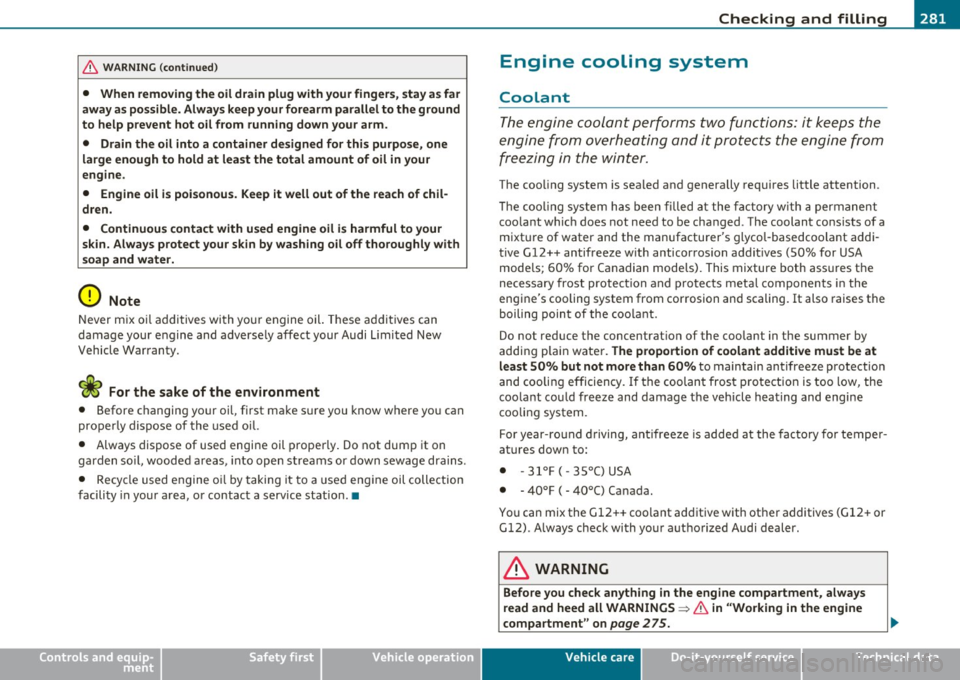
___________________________________________ C_ h_e _c _k_ i_n ~g_ a_n_ d_ f_ i_ll _i_n _g __ _
& WARNING (co ntinued )
• When removing the oil drain plug w ith your fingers , sta y as far
away as possible . Alway s keep your forearm parallel to the ground
to help p revent hot oil from running down your arm.
• Drain the oil into a container de signed for this purpose, one
large enough to hold at least the total amount of oil in your
engine .
• Engine oil is poisonous. Keep it well out of the reach of chil
dren.
• Continuous contact with u sed engine oil is harmful to your
skin. Always protect your skin by washing oil off thoroughly with
soap and water.
0 Note
N ever mix o il additives wi th you r engine oil. These a dditives can
damage your engine and adversely affect your Audi L imited New
Vehicle Warranty.
ffi For the sake of the environment
• Before changing your oil, first ma ke s ure you know w here yo u can
prope rly dispose of the used o il.
• Always dispose of used engine oil properly . Do not dump it on
garden so il, wooded areas , into open streams or down sewage drains .
• Recy cle used e ngine o il by taking it to a used eng ine oil colle ction
facili ty in your area, or contact a service statio n.•
Safety first
Engine cooling system
Coolant
The engine coolant performs two functions: it keeps the
engi ne f rom over heat in g and it prote cts the engine fro m
free zing in the winter .
The coo ling system is sealed and generally requires little attention.
Th e cool ing sys tem h as been filled a t the f actory w ith a permanent
coo lant wh ic h does not need to be changed . The coolant consists of a
mi xtu re of water and the manufacturer 's glyco l-basedcoo lant add i
t ive Gl2++ antifreeze w ith anticor ros ion addit ives (50% for USA
mode ls ; 60% for Ca nadian mode ls). This mixture both ass ures the
necessa ry frost protect ion and p rotects meta l components in the
engine's cooling system from corrosion and scaling. It also raises the
boiling poin t of the coo lant.
Do not red uce the concentrat io n of the coolant in t he summer by
adding p lain wate r. The proportion of coolant additive must be at
least 50 % but not more than 60 %
to maintain antifreeze protection
and coolin g efficiency. If the coolan t fros t pro tection is too low , the
coo la nt cou ld freeze and damage t he veh icle heat ing and engine
cooling system .
For year-ro und d riving, a ntifree ze is adde d at the fac to ry fo r tempe r
atures down to:
• - 31°F(-3 5°C) USA
• -40°F ( -40°() Canada.
Yo u can mix the Gl2 ++ coo lant add itive with other additives (G12 + or
Gl2) . A lways check wi th yo ur auth o rized Audi dealer .
& WARNING
Before you check anything in the engine compartment, always
read and heed all WARNINGS =>
& in "Working in the engine
compartment " on
page 275.
Vehicle care Technical data
Page 284 of 362
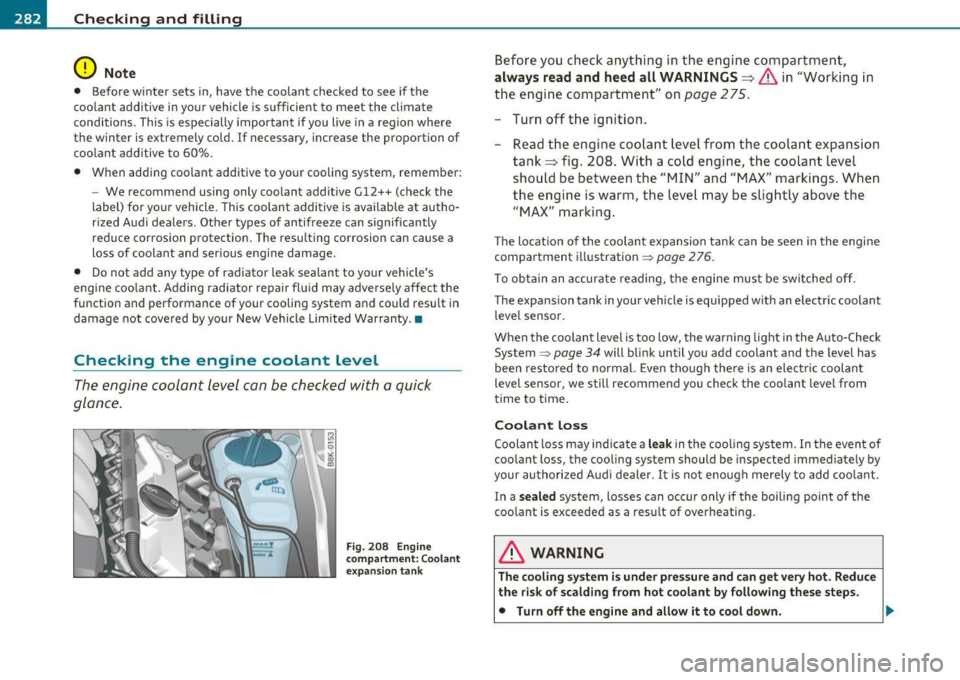
___ C_h_ e_c _k _i_n -=g :a,__ a_n_ d_ f_ i_ l _li _n _,g;._ __________________________________________ _
0 Note
• Before w inter sets in, have the coolant checked to see if the
coolant additive in your vehicle is sufficient to meet the climate
conditions. This is especially important if yo u live in a region where
the winter is extremely cold.
If necessary, increase the proportion of
coolant additive to 60% .
• When adding coolant additive to your cooling system, remember :
- We recommend using only coolant additive G12++ (check the
label) for your vehicle. This coolant additive is available at autho
r iz ed Audi dealers. Other types of antifreeze can s ignificantly
reduce corrosion protection. The resulting corrosion can cause a
loss of coolant and serious engine damage.
• Do not add any type of radiator leak sealant to your vehicle 's
engine coolant. Adding radiator repair flu id may adversely affect the
function and performance of your cooling system and cou ld result in
damage not covered by your New Vehicle Limited Warranty .•
Checking the engine coolant Level
The engine coolant level can be checked with a quick
glance.
Fig. 208 Engine
co mpartment : Coolant
expansion tank
Before you check anything in the engine compartment,
always read and heed all WARNINGS~ & in "Working in
the engine compartment" on
page 275.
-Turn off the ignition.
- Read the engine coolant level from the coolant expansion
tank~ fig. 208 . With a cold engine, the coolant level
should be between the "MIN" and "MAX" markings. When
the engine is warm, the level may be slightly above the
"MAX" marking.
The locat io n of the coolant expansion tank can be seen in the engine
compartment illustration~
page 276.
To obtain an accurate reading, the engine must be switched off.
The expansion tank in your vehicle is equipped with an electric coolant level sensor.
When the coolant level is too low, the warning light in the Auto-Check
System =>
page 34 will blink until you add coolant and the level has
been resto red to normal. Even though there is an electric coolant
level sensor, we still recommend you check the coolant level from
time to time.
Coolant loss
Coolant loss may indicate a leak in the coo ling system. In the event of
coolant loss, the cooling system should be inspected immediately by
your authorized Audi dealer. It is not enough merely to add coolant.
In a
sealed system, losses can occur only if the boiling point of the
coo lant is exceeded as a result of overheating .
& WARNING
The cooling system is under pressure and can get very hot. Reduce
the risk of scalding from hot coolant by following these steps.
• Turn off the engine and allow it to cool down.
Page 285 of 362
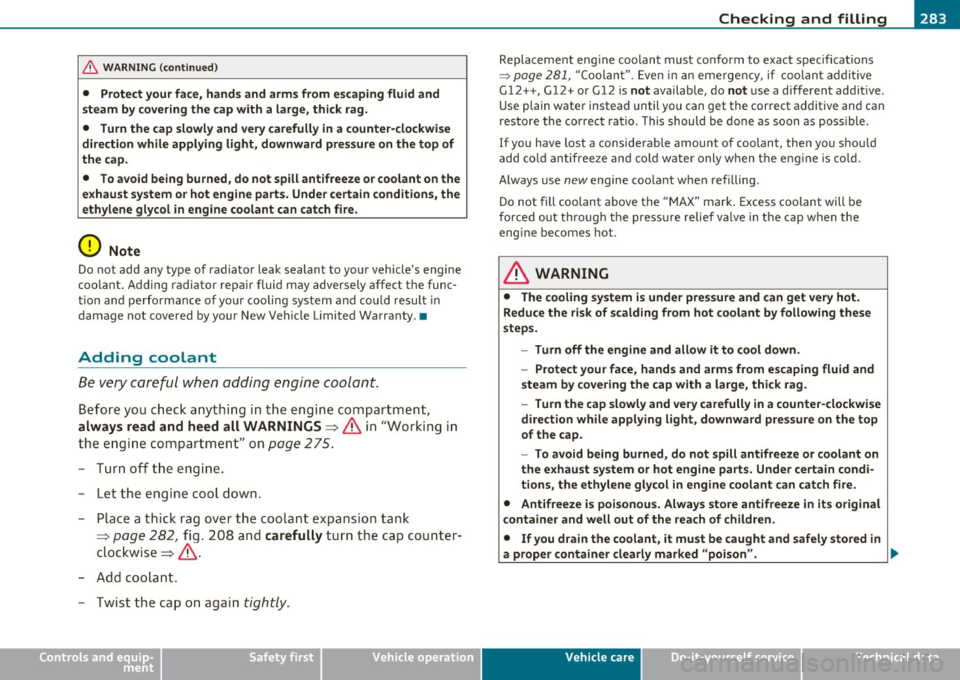
___________________________________________ C_ h_e _c _k_ i_n ~g_ a_n_ d_ f_ i_ll _i_n _g __ _
& WARNING (co ntinued )
• Prote ct your face , hands and arms from escaping fluid and
st eam by covering the cap with a large, thick rag.
• Turn the cap slowl y and very carefully in a counter-clockwise
d irection while applying light, downward pressure on the top of
the cap.
• To avoid being burned, do not spill ant ifreeze or coolant on the
exhaust system or hot engine part s. Under certain conditions , the
e thylene glycol in engine coolant can catch fire .
0 Note
Do not add any type of radia tor leak sealant to your vehicle 's eng ine
coo la nt. Adding radiator repair fluid may adverse ly affect the func
t ion and pe rforma nce o f yo ur cooling system and could result in
damage not covered by yo ur New Vehicle Limited Warranty. •
Adding coolant
Be very careful when adding engine co olant.
Before you c heck anythi ng in the eng ine co mpart men t,
always read and heed all WARNINGS~ & in "W ork ing in
the e ngine compartm ent" on
page 2 75.
- Turn o ff t he engine.
- Let t he engine cool dow n.
- Place a thi ck rag over the coolan t expans io n tank
~ page 282 , fig . 2 08 a nd carefully turn the ca p cou nter
clockw ise
~ & .
- Ad d cool ant .
- Twist t he ca p on again
tightly.
Safety first
Replaceme nt eng ine coolant must conform to exact spec ifications
=> page 281, "Cool an t". Even in an emerge ncy, i f coolan t additive
Gl2 ++, Gl2+ or Gl2 is not available, do not use a different add itive .
U se plain water instead until you can get the correct additive and ca n
restore the correct ratio . This should be done as soon as possible .
If you have lost a considerable amount of coolant, then you shou ld
add co ld antifree ze and co ld wate r only w hen t he e ng ine is co ld .
Always use
new engine coo la nt w hen refi lling.
Do not fill coolant a bove the "M AX" mark . Excess coolant will be
forced ou t thr ough t he pr ess ure relief va lve in t he cap when the
engine becomes hot.
& WARNING
• The cooling system i s under pressure and can get very hot.
Reduce the risk of scalding from hot coolant by following these
steps.
-Turn off the engine and allow it to cool down .
- Protect your face , hands and arms from escaping fluid and
steam by covering the cap with a large, thick rag.
- Turn the cap slowly and very carefully in a counter-clockwise
direction while applying light, downward pre ssure on the top
of the cap .
- To avoid be ing burned, do not spill antifreeze or coolant on
the exhaust system or hot engine parts. Under certain condi
tions, the ethylene glycol in engine coolant can catch fire.
• Antifreeze i s poisonous . Always store antifreeze in its original
c ontainer and well out of the reach of children .
• If you drain the coolant, it must be caught and safely stored in
a proper container clearly marked "poison ". ..
Vehicle care Technical data
Page 286 of 362
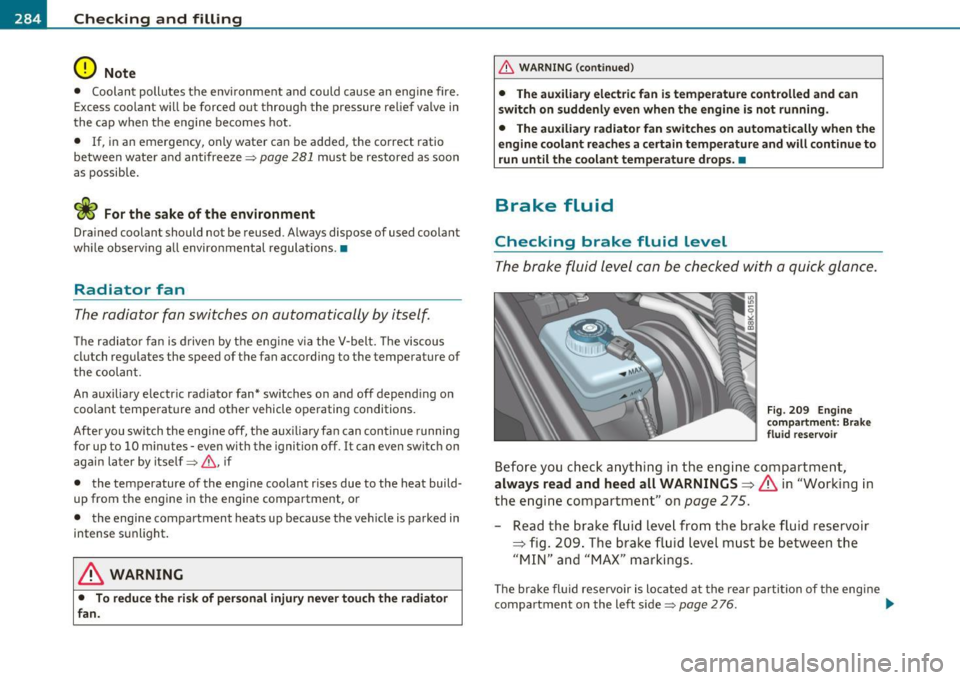
•--=C:.:.h.:.. e=. c=.:..:: k .:.:in ..:. g ~ a::..:..: n~d .:...:.. f:....:il ..:.li :.:.n.;.: g~ ------------------------------------------
0 Note
• Coolant pollutes the environment and could cause an engine fire.
Excess coolant will be forced out through the pressure relief valve in
the cap when the engine becomes hot .
• If, in an emergency, only water can be added, the correct ratio
between water a nd antifreeze ::::>
page 281 must be restored as soon
as possible.
ci> For the sake of the environment
Drained coolant should not be reused. Always dispose of used coolant
wh ile observ ing all environmental regulations.•
Radiator fan
The radiator fan switches on automatically by itself.
The radiator fan is driven by the engine v ia the V-belt. The viscous
clutch regulates the speed of the fan according to the temperature of
t he coo lant.
An auxiliary electr ic radiator fan* sw itches on and off depending on
coolant temperature and other vehicle operating conditions.
After you switch the engine off, the auxiliary fan can cont inue running
for up to 10 minutes- even with the ignition off. It can even switch on
again later by itse lf::::>
/1 , if
• the temperature of the engine coolant rises due to the heat build
up from the engine in the engine compartment, or
• the engine compartment heats up because the veh icle is parked in
intense sunlight.
& WARNING
• To reduce the risk of personal injury never touch the radiator
fan.
/1 WARNING (continued)
• The auxiliary electric fan is temperature controlled and can
switch on suddenly even when the engine is not running.
• The auxiliary radiator fan switches on automatically when the
engine coolant reaches a certain temperature and will continue to
run until the coolant temperature drops .•
Brake fluid
Checking brake fluid level
The brake fluid level can be checked with a quick glance.
Fig . 209 Engine
co mpartm ent : Brake
fluid reservoir
Before you check anything in the engine compartment,
always read and heed all WARNINGS=> & in "Working in
the engine compartment" on
page 275.
-Read the brake fluid level from the brake fluid reservoir
=> fig. 209. The brake fluid level must be between the
"MIN" and "MAX" markings.
The brake fluid reservoir is located at the rear partition of the engine
compartment on the left side=>
page 276. .,
Page 292 of 362
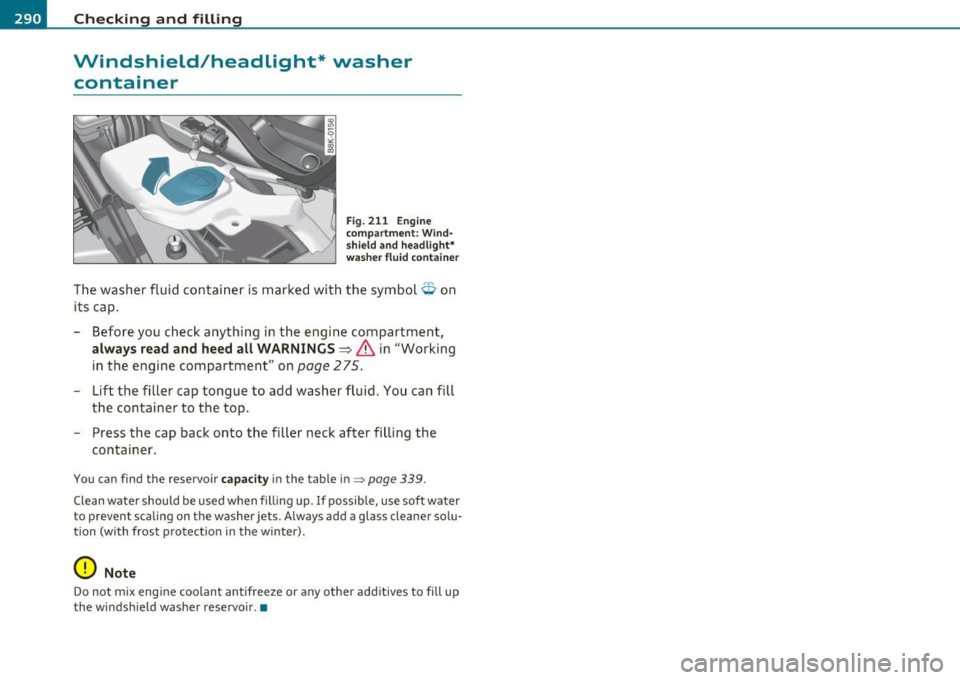
___ C_h_ e_c _k _i_n -=g :a,__ a_n_ d_ f_ i_ l _li _n _,g;._ __________________________________________ _
Windshield/headlight* washer
container
Fig. 211 E ngine
compartment: Wind
shie ld and headlight*
washer fluid container
The washer fluid container is mark ed with the symbol¢ on
its cap.
- Before you check anything in the engine compartment,
always read and heed all WARNINGS => & in "Working
in the engine compartment" on
page 275.
- Lift the filler cap tongue to add washer fluid. You can fill
the container to the top.
- Press the cap back onto the filler neck after filling the
container .
You can find the reservoir capacity in the table in:::::::, page 339.
Clean water should be used when filling up. If possible, use soft water
to prevent scaling on the washer jets. Always add a glass cleaner solu tion (with frost protection in the winter) .
0 Note
Do not mix engine coolant antifreeze or any other additives to fill up
the windsh ield washer reservoir .•
Page 343 of 362

______________________________________________ C _o_ n _ s_u_ m_ e_r_ I_n _f_ o_ r_m _ a_t_ i_ o _ n __ _
• oil cha nges, and
• cl ea ning or re placing th e air fi lter.
W For the sake of the environment
By regu larly ma intaini ng yo ur vehicl e, y ou h elp m ake su re th at em is
sion standards a re mainta ined, t hus mi nimizing adverse effects o n
t he enviro nmen t. •
Important considerations for you and your
vehicle
Th e increas ing use of elect ronics, s ophistica ted fuel inje ct io n and
em ission cont rol systems, and t he generally increasing tec hnical
c omplex ity o f today' s automobile s, have s tea dil y re duced t he s cope
of maintena nce and repairs w hic h can be carr ied out by ve hicle
ow ners.
Also, safety and environmental c o nce rn s plac e very s trict
limits o n the nature of repa irs and adjustments to engine an d tra ns
mission parts w hich an owner can pe rform .
M ain te nance, ad justm ents and r epairs us ua lly re quir e spec ia l t ools,
test ing devices an d other e quipment availab le to s pecia lly trained
wo rksh op pe rsonnel in order to assure pro per perfor mance, re li
ability and safety of the vehicle and its many systems.
Impro per ma inte nance, adjustments and rep airs can im pa ir the ope r
ation and reliability of your ve hicle and even void your veh icle
wa rranty . Therefo re, p ro of of se rvicing in a ccordance wi th t he ma in
t enance sch edul e may be a co nd it io n fo r u phold ing a possib le
wa rranty claim made w it h in the wa rranty pe riod.
Above all, operat io nal safety ca n be adve rsely affec ted, c reat ing
unnecessary r is ks for you and your passe ngers.
If in doubt abou t any serv ic ing, have it done by your authorized Audi
dealer or a ny o ther pro perly equipped a nd qualified workshop . W e
st rong ly ur ge you to give yo ur auth oriz e d Aud i dea ler the opportu nity
t o pe rform all sc heduled mainte na nce and necessary repairs. Yo ur
Safety first
dealer has the facilities, o rigina l parts and trained spec ia lists to keep
your vehi cle runni ng properly.
Performing limited maintenance yourself
The foll ow ing page s descr ibe a lim ite d num ber of proced ures whi ch
can be perfo rmed on your vehicle w it h ordina ry tools, shou ld the need
ar ise and tr ained pe rsonnel be u navailabl e. Befo re pe rforming any of
t hese p rocedures, always t horoughly read all of the applicable text
and ca ref ull y follow the ins tru ction s given . Alw ays rigoro usly o bserve
t he
WARNINGS prov ided .
Before you check anything in the engine compartment, always read
and heed all WARNINGS=>
& and=> & in "W orking in the engine
compartment" on
page 275.
& WARNING
• Serious personal injury may occur as a result of improperly
performed maintenance, adjustments or repairs.
• Always be extremely careful when working on the vehicle.
Always follow commonly accepted safety practices and general
common sense . Never risk personal injury .
• Do not attempt any of the maintenance, checks or repairs
described on the following pages if you are not fully familiar with
these or other procedures with respect to the vehicle, or are uncer
tain how to proceed.
• Do not do any work without the proper tools and equipment .
Have the necessary work done by your authorized Audi dealer or
another properly equipped and qualified workshop .
• The engine compartment of any motor vehicle is a potentially
hazardous area. Never reach into the area around or touch the
radiator fan. It is temperature controlled and can switch on
suddenly -even when the engine is off and the ignition key has
been removed. The radiator fan switches on automatically when
the coolant reaches a certain temperature and will continue to run until the coolant temperature drops. ..
Do-it,yourself service Technical data
Page 348 of 362
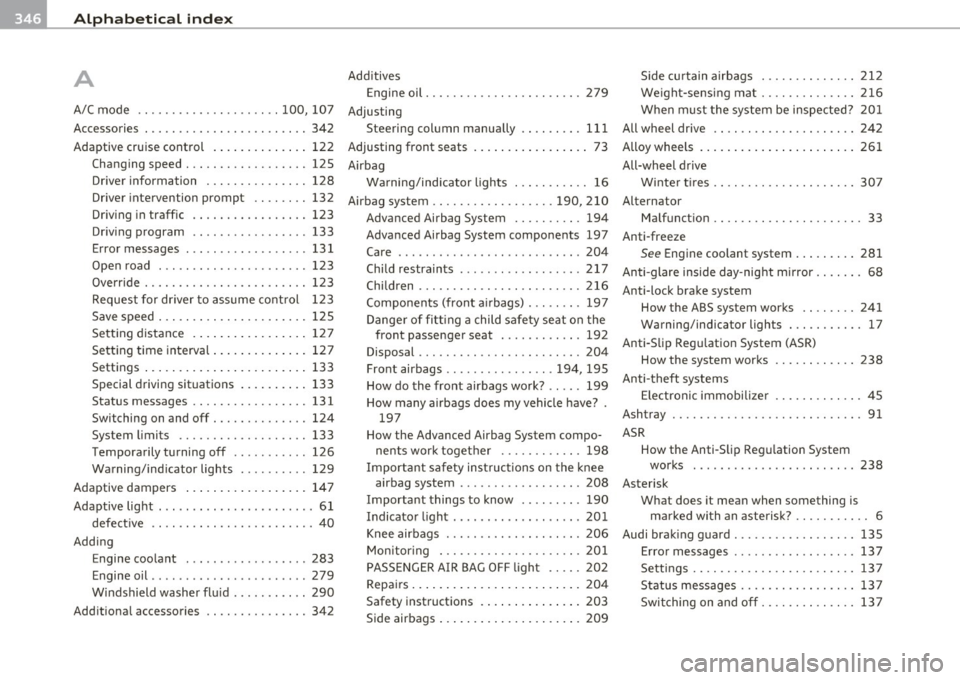
___ A_ l_. p_ h _ a_b_ e_ t_ic _a_ l_ in_ d_e _ x ____________________________________________ _
A Additives
Engine oil .......... .. .. .. .. .. ... 279
A/C mode ................. .. .. 100, 107
Adjusting
Accessories ... .. ..... ....... ....... 342 Steering column manually .. .. .. .. . 111
Adaptive cruise control .............. 122 Adjusting front seats ......... .. .. .. .. 73
Changing speed . .. ...... ......... 125
Airbag
Driver information ............. .. 128
Warning/indicator lights ..... .... .. 16
Driver intervention prompt ...... .. 132
Airbag system .. ................ 190, 210
Driving in traffic .. .. ... ... .... ... 123
Advanced Airbag System ......... . 194
Dr iving program .. .. .. ... ........ 133
Advanced Airbag System components 197
Error messages . . . . . . . . . . . . . . . . . . 131
Care ............... ........ ... . 204
Open road ...... ... ............. 123
Child restraints ... ... ... .. .. .. .. . 217
Override ................ ...... .. 123
Children ....... .. .... .... .. ..... 216
Request for driver to ass ume control 123
Components (front airbags) . .. .... . 197
Save speed . .. .. .. .. .. .. ......... 125
Danger of fitting a child safety seat on the
Setting distance ................. 127
front passenger seat ............ 19 2
Setting time interva l .............. 127
Disposal .... ... .. ... ... .. .. .. .. . 204
Settings ..................... ... 133
Front airbags .......... ...... 194, 195
Special driving situations .......... 133
How do the front airbags work? ..... 199
Status messages ........ ......... 131
How many airbags does my vehicle have? .
Switching on and off .............. 124 197
System limits ................. .. 133 How the Advanced Airbag System compo-
Temporarily turning off ...... .. ... 126 nents
work together ............ 198
Warning/ind icator lights .......... 129 Important safety
instructions on the knee
Adaptive dampers ... ............... 147
Adapt ive light ... .. .. .. .... ...... ... . 61
defect ive ...... .. .. .... .......... 40 airbag system
........... .. .. .. . 208
Important things to know ........ . 190
Indicator light ...... .. ... ... .. .. . 201
Adding Engine coolant ..... ............. 283
Engine oil ....... ......... ....... 279
Windshield washer fluid ........ . .. 290
Additional accessories .. .. .. ......... 342 Knee airbags
........... .. .. .... . 206
Monitor ing . .. ................. . 201
PASSENGER A IR BAG OFF l ight ..... 202
Repairs ......... .... ..... .. .. ... 204
Safety instructions ........ .. .. ... 203
Side airbags ................... .. 209 Side curtain airbags
............ .. 212
We ight-sensing mat ...... .. .. .. .. 216
When must the system be inspected? 201
All wheel drive .. .. .. .. .. .... ... .. .. 242
Alloy wheels ............ .... ..... .. 261
All-wheel drive
Winter t ires .. .. .... ............. 307
Alternator Malfunction .. .. .. .. .............. 33
Anti-freeze
See Engine coolant system ......... 281
Anti-glare inside day-night mirror ...... . 68
Anti-lock brake system
How the ABS system works ...... .. 241
Warning/indicator lights ........ ... 17
Anti-Slip Regu lation System (ASR)
How the system works
Anti-theft systems 238
Electronic immobilizer ...... .... .. . 45
Ashtray ............... ............ . 91
A5R How the Anti -Slip Regu lation System
works ................. ... .... 238
Asterisk What does it mean when something is
ma rked with an asterisk? . . . . . . . . . . . 6
Audi braking guard .... ....... ... .. .. 135
Error messages .... .... .. .. .. .. .. 137
Settings ........ .. .. .. .. .. .. .. .. 137
Status messages ............... .. 137
Switching on and off .......... .. .. 137
Page 350 of 362
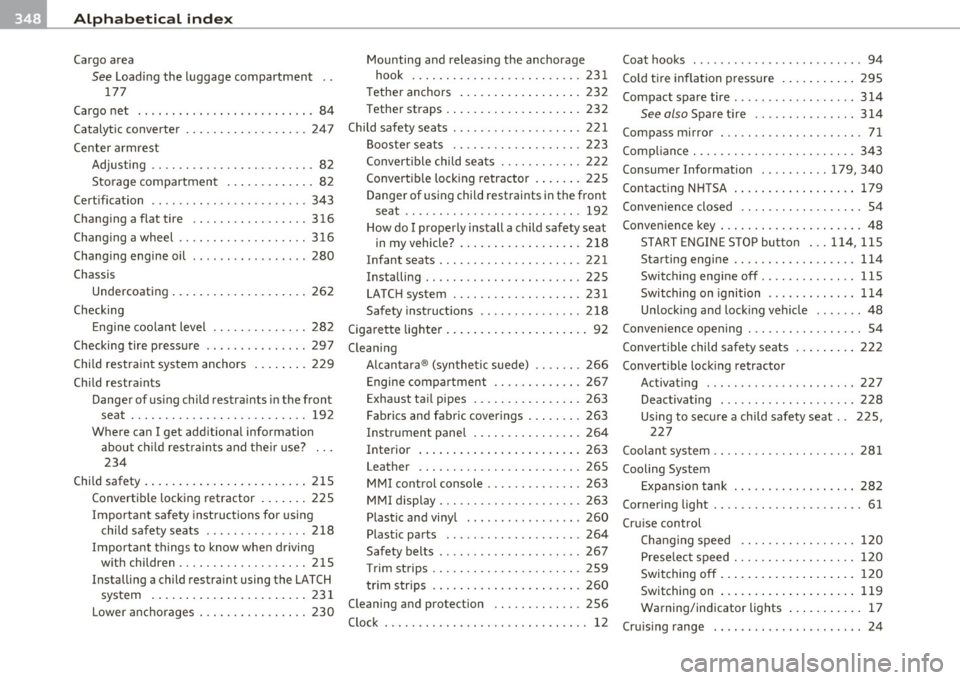
___ A_ l_,, p_ h _ a_b_ e_ t_ic _a_ l_ in_ d_e _ x ____________________________________________ _
Cargo area
See Loading the luggage compartment
177
Cargo net .. .. ... ..... .. .. .. .. .. . .. . 84
Catalytic converter .................. 247
Center a rmrest
Adjusting .. .. .................... 82
Sto rage compartment ... ..... ..... 82
Cert ification .. .. .. .. .. .. ... .... .... 343
Changing a flat ti re .. .. .. .. ......... 316
Cha ng ing a wheel ........... .. .. .. .. 316
Chang ing engine oil .. .. ... .......... 280
Chassis Undercoating ... .. .. ...... .... . .. 262
Checking Engine coo lant level ........ .... .. 282
Checking tire pressure ............ ... 297
Child res tra int system anchors ... .. .. . 229
Child restra ints
Dange r of using chi ld restraints in the front
seat ........ ...... ...... .. .. .. 192
Where can I get add itiona l information
a bou t child rest rain ts and t he ir u se? ...
234
Chi ld safety ....... ... ... .. ... ... ... 215
Convertible locking retractor . ... ... 225
Important sa fety instructions for using
child safety seats .... .... ... .. .. 218
Importa nt th ings to know whe n driving
w ith children ................. .. 215
Insta lling a child restraint using the LATCH
system . ... ..... ....... .. .. . .. 231
Lower anchorages . ............. .. 230 Mounting and releas
ing the anchorage Coat hooks ... ... ... .. .. .... ... . ... . 94
hook ........ .. .... ...... ..... 23 1
Cold t ire inflation p ressure .... ... . ... 295
T ethe r anchors .. ... .. .. .. .. .... . 232
T ethe r straps . ....... .. .. ... .. .. . 232 Compact spare tire
........... ....... 314
See also Spare t ire ............... 314
Chi ld safety seats ............ .. .. .. . 221
Booste r se ats .. .. .... .... .. .... . 223
Convert ible chi ld sea ts ......... .. . 222
Convert ib le lock ing retractor . ... ... 225
Dange r of using child restraints in the front
seat .. .. .. .. .. ... ... ... .. ... .. 192 Compass mirror .
.... .. .............. 71
Com pliance . ................. .... .. 343
Consumer Information ... .... ... 179, 340
Contacting N HTSA ....... .. ... .... .. 179
Conven ience closed .. .. .. .. .......... 54
How do I p roperly install a child safety seat Conven
ience key . .. .. .. ............. . 48
in my vehicle? ...... .. .. ... .. .. . 218 START ENGINE STOP button .
.. 114, 115
In fant seats .............. .. ..... 221 Starting engine ..
... ..... .. .. .. .. 114
Insta lling .. .... .. .. .. .. . ... .. ... 225 Switching eng
ine off ...... .. .. .... 115
LATC H system .. ...... ...... ..... 231 Switching on
ignition ........ ... .. 114
Safety instruct ions .. .. .. .. .. .. ... 218 Unlock
ing and lock ing vehi cle ... .... 48
Cigare tte lig hter . ... .... ... . ... .... .. 92 Conven
ience opening . .. .... .......... 54
Cleaning Convert
ible chi ld safety seats .. ... .. .. 2 22
Al canta ra ® (syn the tic sue de) .. .... . 266
Convert ible lock ing retractor
E ngine comp artment ...... .. .. .. . 267
Activat ing .... ........... ... .... 227
E xhaust t ail pipes .... ... . ... .. .. . 263
Deactivating ... ... .... ..... .... . 228
Fabrics an d fabric cove rings ... .... . 263
Using to secu re a child safety seat . . 225,
Instrument panel ..... .. . ... .... . 264 227
Interior .. .. ... .. .. .. .... .. .. .. . 263
Coolant system .. .... .. ............. 28 1
Leathe r ............. .... .. ..... 265
Cooling System
MMI control console ............. . 263
Expansion tank ........... ... ... . 282
M MI display . .. .. ............... . 263
Cornering light .... .. .. .... .......... 61
Plastic and viny l ............... .. 260
Cruise con trol
Plastic parts ........... .. ... ... . 26 4
Safety belts ......... ... .. .. .. .. . 267
Tr im st rips ..... ...... .... .. .. .. . 259
tr im str ips .. .. ........... .. .. .. . 260 Ch
angin g speed .. .. .... ......... 1 20
Prese lect speed ...... .. .. .. .... .. 12 0
Switching off ... .. .. .. .. ... .. .. .. 120
Switching on ... .. .. .. .. ... .. ... . 119
Cleaning and protection ...... .. .. .. . 256
Warning/indicator lights ... .. .. ... . 17
Clo ck ............ ...... ...... .. .. .. 12
Cruis ing range .. ... . .. .... ... ..... .. 24